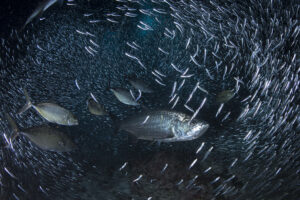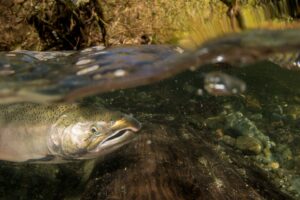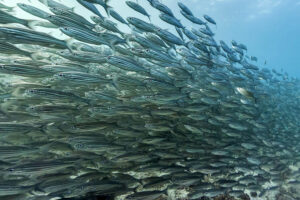It’s been a big weekend in the Salish Sea!
After enduring the full month of August without Southern Resident Killer Whale (SRKW) encounters, September came and the party began. A new baby orca joined J Pod on Thursday! Then the first superpod of SRKWs of the year came together in the waters of the Strait of Juan de Fuca near the Dungeness Spit.

No one knows what brings J, K, and L Pods together in a superpod, but it is fun to wonder if it might have been the birth of a new calf! We knew from aerial photographs that a couple of Southern Residents, including J35, were pregnant and due to give birth soon, but it wasn’t until Gary Sutton (@gary_j27) spotted the small dorsal fin next to its mother on Sunday that we knew J35’s calf had arrived. Social media feeds went wild over the news, blowing up my phone all afternoon!
The Center for Whale Research (CWR) deployed boats with researchers to photograph the calf and every individual whale in the superpod to verify that all the whales were accounted for. CWR assigned J57 as the calf’s designation and September 4th as its birthday. We won’t know if it is a male or a female until we can get a look at its belly. I hope it’s a female because we need more reproduction.
We now have 73 free Southern Residents
J57’s birth brings the number of endangered Southern Resident Killer Whales (SRKWs) up to 73. Lolita is the 74th living member of this community, but she remains held in captivity in Miami Seaquarium after being taken from the Salish Sea 50 years ago.1
J57 was born to J35, who is nicknamed Talequah. She caught the world’s attention in 2018 when her newborn calf died and she carried it for 17 days over 1,000 miles in what looked to most of us like a universal display of supreme grief. In contrast, it appears J57 is starting out strong:
“J35’s new calf appeared happy and precocious, swimming vigorously alongside its mother in its second day of free-swimming life.”
The Center for Whale Research, September 6, 2020
High mortality rate for calves
The celebration of J57’s birth is justified, but the calf’s future is full of risk. The SRKWs have been on the US Endangered Species and Canadian Species at Risk lists since 2005. A combination of factors has put this community under stress, and all of them are pretty much our fault.
Captured
First, we weakened the population by capturing 58 young whales from this community from 1962-1976.2 Lolita is the last living whale from this captured group. Taking the young whales, especially females, seriously compromised their ability to reproduce. Here is a video of the captures at Penn Cove, but I’ll warn you – it’s hard to watch.
Insufficient food
Second, while some orcas eat mammals such as seals, the SRKWs have specialized in eating fish. Not just any fish. 80% of their diet is Chinook salmon, also known as King salmon. The average whale eats 18-25 salmon per day. That means that the SRKW population must find more than 510,000 salmon per year.3 The problem is that the salmon are disappearing due to overfishing, stream bed habitat destruction, and warming river temperatures.
“In Puget Sound, only 22 of at least 37 historic Chinook populations remain. The remaining wild Chinook salmon are at 10% of their historic numbers.”4

Contaminants
Third, when they do eat, they fall victim to a group of toxins and contaminants called persistent organic pollutants (POPs) that we allow to flow into the sea from the watersheds in which we live.
Orcas are apex predators. They eat at the top of the food web. They eat salmon, who eat smaller fish, such as herring, who eat smaller fish, crustaceans, and plankton. Each of those animals is absorbing POPs from their food. (See my previous post called What mussels can tell us about water quality). At each level of the web, POPs get more and more concentrated over time.

They build up inside the adult orcas causing a long list of problems including endocrine disorders, reproductive dysfunction, a compromised immune system, and cancer.5 Then the POPs infiltrate the mother’s milk and get transferred to the calves. POPs can impact calf growth rates, future fertility, and can slow learning and impair memory, making it harder for calves to learn to hunt and socialize with their pod.6
Noise and vessel impact
Fourth, the large number of motorized vessels that move through the Salish Sea, from massive tankers to small recreational boats, make a lot of noise that travels long distances underwater. Orcas use sound in the form of echolocation, whistles, and calls to find food and each other. Our loud noises interfere with their ability to hunt and communicate. It’s not unlike trying to have a conversation with someone at a rock concert. It doesn’t work very well.
All of these factors contribute to health problems for the adults, a high miscarriage rate for females, and a high mortality rate for calves in the SRKW population. 40% of newborn SRKW calves do not survive their first year.7
We can do something about it
Protect the salmon
- Eat something else! Leave King Salmon for the orcas.
- Restore and protect salmon habitats in our watersheds.
- Learn both sides of the regional dam removal discussion and push decision-makers to adopt effective solutions.
Improve water quality
- Dispose of pharmaceuticals in the drop box at your drug store. Don’t flush them.
- Don’t dump ANYTHING into neighborhood stormwater drains.
- Wash your car at a commercial carwash that recycles the water.
- Use non-toxic garden supplies and cleansers in your home.
- Use your legs more often. Your car’s exhaust, brake pads, and tires release heavy metals and pollutants every time you use it.
- Put your trash and recycling into proper bins, not on the ground.
- Pick up your pet’s poop and put it in the trash.
Reduce noise
- Give them some space! When on the water, follow US and Canadian regulations for slowing speed and increasing distance from the whales.
Looking forward to more good news
I am still anxiously anticipating the birth of L72’s calf who is apparently due very soon. Many recent pregnancies have not resulted in successful births, so I really hope that J35, J57, L72, and her calf get through this first critical year in good health with clean food to eat and quiet places to rest.
Go Deeper!
- The Center for Whale Research
- Be Whale Wise Guidelines
- NOAA Fisheries. Toxic Killer Whales
- Catalina Island Marine Institute. Bioaccumulation And Biomagnification: Increasingly Concentrated Problems!
End Notes
1 Mapes, Lynda V. “Remembering Lolita, an Orca Taken Nearly 49 Years Ago and Still in Captivity at the Miami Seaquarium.” The Seattle Times, The Seattle Times Company, 17 June 2019, www.seattletimes.com/seattle-news/environment/remembering-lolita-nearly-49-years-still-in-captivity-at-the-miami-seaquarium/.
2 “Baby Wild Films Presents: The Killer Whale People”, https://www.youtube.com/watch?v=ho2-WFC7j6U
3-4 “Orcas and Where They Find Salmon.” CWR, Center for Whale Research, www.whaleresearch.com/orcassalmon.
5-6 Fisheries, NOAA. “Toxic Killer Whales.” NOAA, 28 Aug. 2019, www.fisheries.noaa.gov/feature-story/toxic-killer-whales.
7 “J57.” CWR, Center for Whale Research, 6 Sept. 2020, www.whaleresearch.com/j57.






Leave a Reply
Your comments are welcome.